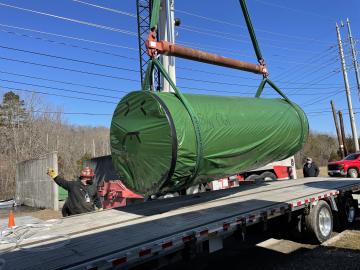Filter News
Area of Research
- (-) Advanced Manufacturing (7)
- (-) Supercomputing (21)
- Biology and Environment (37)
- Building Technologies (1)
- Clean Energy (69)
- Computational Biology (1)
- Computational Engineering (2)
- Computer Science (4)
- Electricity and Smart Grid (1)
- Fusion and Fission (14)
- Fusion Energy (1)
- Isotopes (12)
- Materials (15)
- Materials for Computing (18)
- Mathematics (1)
- National Security (7)
- Neutron Science (16)
- Nuclear Science and Technology (1)
- Quantum information Science (3)
- Sensors and Controls (1)
- Transportation Systems (1)
News Topics
- 3-D Printing/Advanced Manufacturing (7)
- Artificial Intelligence (3)
- Biology (1)
- Biomedical (1)
- Buildings (1)
- Chemical Sciences (1)
- Climate Change (3)
- Composites (2)
- Computer Science (15)
- Coronavirus (2)
- Cybersecurity (2)
- Energy Storage (2)
- Environment (6)
- Frontier (3)
- High-Performance Computing (10)
- Machine Learning (1)
- Materials (5)
- Materials Science (4)
- Microscopy (2)
- Nanotechnology (1)
- National Security (1)
- Neutron Science (3)
- Physics (1)
- Quantum Computing (5)
- Quantum Science (3)
- Security (1)
- Space Exploration (1)
- Summit (5)
- Sustainable Energy (4)
- Transportation (1)
Media Contacts

Improved data, models and analyses from ORNL scientists and many other researchers in the latest global climate assessment report provide new levels of certainty about what the future holds for the planet

The receipt of a nuclear fuel canister is boosting the research of an Oak Ridge National Laboratory team investigating methods to help the nation effectively dispose of nuclear waste for the long term.

A research team at Oak Ridge National Laboratory have 3D printed a thermal protection shield, or TPS, for a capsule that will launch with the Cygnus cargo spacecraft as part of the supply mission to the International Space Station.

An ORNL-led team comprising researchers from multiple DOE national laboratories is using artificial intelligence and computational screening techniques – in combination with experimental validation – to identify and design five promising drug therapy approaches to target the SARS-CoV-2 virus.

RamSat’s mission is to take pictures of the forests around Gatlinburg, which were destroyed by wildfire in 2016. The mission is wholly designed and carried out by students, teachers and mentors, with support from numerous organizations, including Oak Ridge National Laboratory.

At the Department of Energy’s Oak Ridge National Laboratory, scientists use artificial intelligence, or AI, to accelerate the discovery and development of materials for energy and information technologies.

The Department of Energy’s Oak Ridge National Laboratory has licensed its award-winning artificial intelligence software system, the Multinode Evolutionary Neural Networks for Deep Learning, to General Motors for use in vehicle technology and design.

The U.S. Department of Energy’s Innovative and Novel Computational Impact on Theory and Experiment, or INCITE, program is seeking proposals for high-impact, computationally intensive research campaigns in a broad array of science, engineering and computer science domains.

Oak Ridge National Laboratory researchers combined additive manufacturing with conventional compression molding to produce high-performance thermoplastic composites reinforced with short carbon fibers.

A team of Oak Ridge National Laboratory researchers demonstrated that an additively manufactured hot stamping die – a tool used to create car body components – cooled faster than those produced by conventional manufacturing methods.




